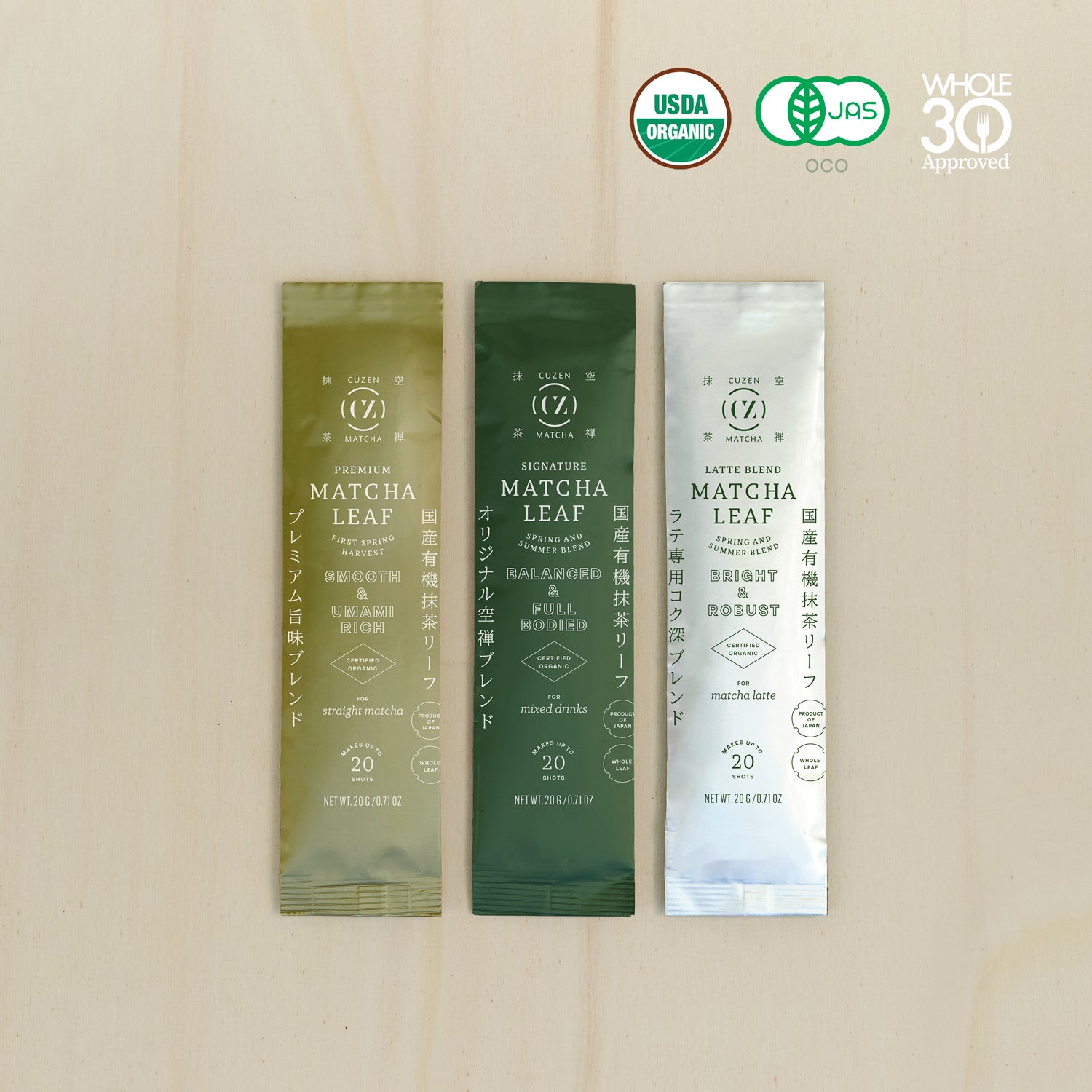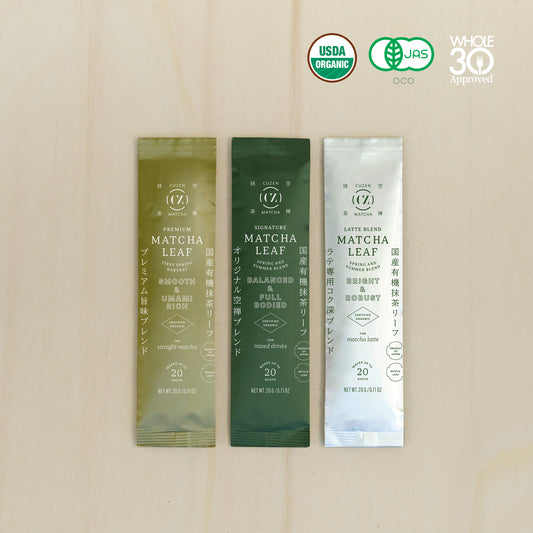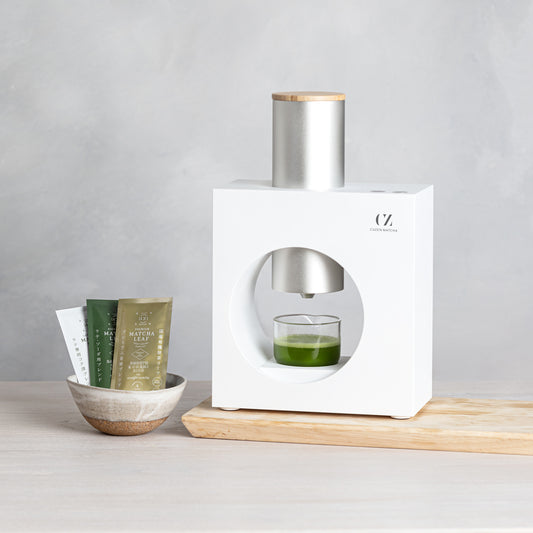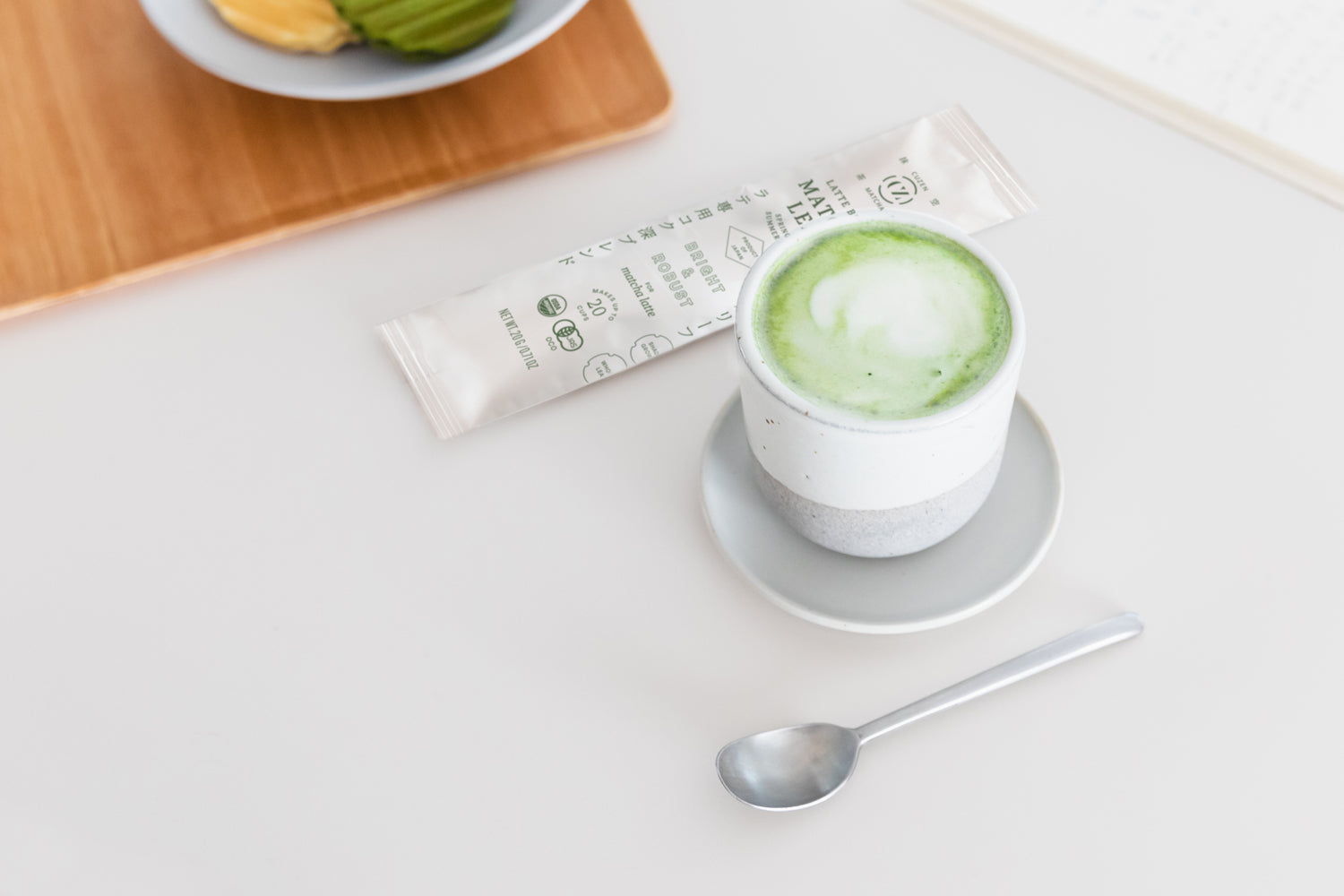
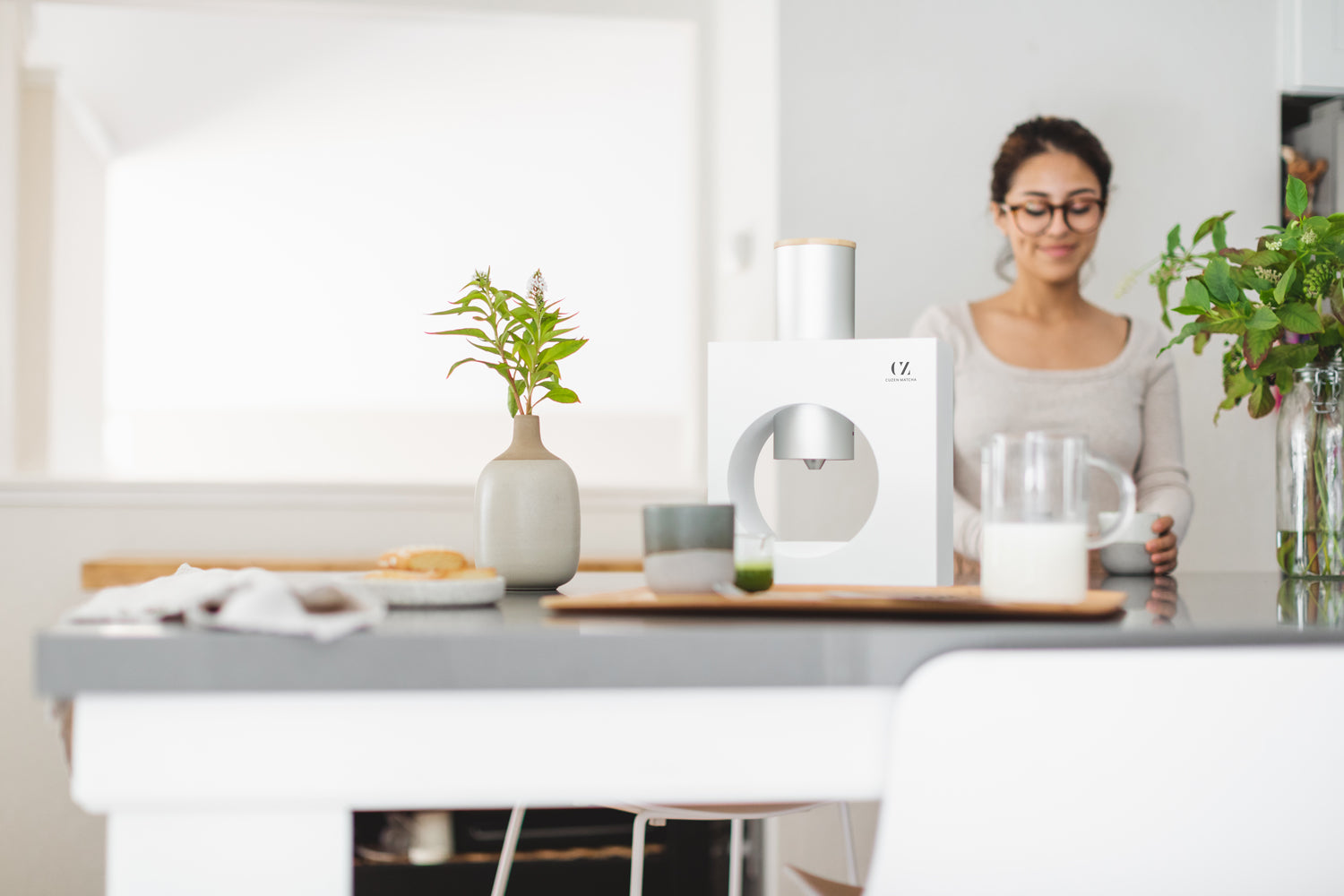
How to prepare the best matcha latte
Until a few years ago, lattes were solely associated with coffee. With a burgeoning interest in matcha, spiced teas and even the turmeric and ginger duo, the standard of a non-cafe latte has become so hazy, that cafe-goers may not know what to expect when they order a matcha latte.
At Cuzen, we prefer a simple recipe with minimal ingredients to compliment, rather than distract from, a high-quality matcha. Cuzen makes freshly-ground powder accessible and the traditional technique of grinding practical.
Contents
- What is a matcha latte?
- Ingredients make the matcha
- How to make the perfect matcha latte
- Best matcha latte recipe
1. What is a matcha latte?
Westerners have become accustomed to the subtleties of matcha and its offshoot, the matcha latte. Despite its popularity, the perfect matcha latte recipe remains somewhat elusive, except in a few specialty cafes and tea houses. The original latte, a coffee drink, has a clear-cut formula: a shot of espresso blended with steamed milk and finished with a thin layer of milk foam. In contrast, the “matcha latte” can comprise premium matcha powder with steamed milk, or it can be a syrupy, poorly-ratioed powder mix, tossed in a blender and poured into a cup. In fact, large coffee chains first popularized the concept of the matcha latte, using matcha blends containing different types of dried milks, dextrin (processed cornstarch), vegetable oil and excess sugar. This can hardly be categorized as matcha, but unfortunately, is a common way to make one. So while a barista can quickly recite a standard formula for a cafe latte, the matcha latte is really quite a new invention and has yet to be standardized.
2. Ingredients make the matcha
The list of ingredients, on the other hand, is quite short. A matcha latte always consists of the following: Matcha, water, milk or plant-based milk, optional sweetener.
As with other recipes, this pared-down ingredient list can be integrated into a spectrum of recipes. The matcha powder is central to flavor and color, the milk determines texture, and the sweetener plays a balancing act among the other ingredients. Each part has a noticeable contribution and so each ingredient must be excellent.
The master and the leaf
Because the base of a matcha latte—the milk—is so creamy in both taste and color, it is important to select an overstated matcha blend. The bitterness should be bolder, and the color should be brighter than that of a blend intended for a straight drink. This blending artistry is all within the scope of the tea master. Like the whisky or coffee blender, the tea master is sensitive to the most subtle nuances of aroma, finish, flavor and color. He or she knows which notes will negate each other, which ones will clash, and which ones will harmonize. When blending for lattes, a tea master will include varieties that gracefully coalesce into a full bodied, umami-rich tea that can thoroughly imbue the milk with flavor and color.
Selecting leaves from organic farmers also makes for a better matcha. Without healthy, clean soil, you cannot have healthy, pure tea. The highest quality leaves come from a farmer who honors the crops, the land, the creatures that live there and the generations that will come after him. This love is in the quality of the finely ground tea leaves and it is there in the cup, as the drinker slowly relishes their sweetness.
This is why we recommend organic matcha blends, such as Cuzen’s Latte Blend or Signature Blend, because those were both developed with the matcha latte in mind. If you exclusively drink lattes, we suggest the Latte Blend. If you like making lattes, but also enjoy a straight matcha or a sparkling matcha, we suggest the Signature Blend.
Freshly-ground
No matter how artful a spice combination or how unusual an ingredient selection, a beverage will never be the best unless the ingredients are fresh. In short, the sum cannot be greater than its parts. This is evident in any food item that must be ground--such as certain spices and coffee. This is especially true about matcha. As soon as matcha leaves are ground, their surface area increases, allowing more oxygen to touch more surface area is more surface area, causing the oxidation process to exponentially accelerate. The more oxygen the matcha is exposed to, the weaker the color, flavor, aroma and health benefits become. This is why traditional tea masters will always grind the leaves just before serving, so that they may have the very best tea to offer their guests. Of course, the average person does not have the space or inclination to keep a large stone mill at home. This is why we engineered a smaller mill for the Matcha Maker, thus providing a similar but more convenient way to have fresh and fine powder.
Water and milk
The quality of wet ingredients will also impact your matcha latte significantly. We suggest using soft water, rather than hard water. The heavy mineral deposits in hard water negatively impact the taste, mouthfeel and color of the tea.
The milk that supports the matcha can be of any type, depending on your preference and dietary restrictions. Keep in mind that there is a subtle flavor difference among types of milk and those with stronger flavors will slightly alter the taste of the latte. Cow’s milk usually has a stronger flavor than many plant-based milks, and we believe that plant-based milks harmonize best with matcha. The taste of high-quality matcha is clean and sophisticated and the elegance of a premium matcha’s umami is masked by the strong taste of cow milk.
Umami-sweet or sweeter
When it comes to sweetening your matcha latte, this is largely a personal preference. Matcha has prominent umami, which already has a natural sweetness. We believe that the umami in the matcha mingles with the natural sugars in milk, and this tastes perfect without any added sweeteners. We do know that sometimes you may like to drink match as a treat. For those occasions, added sweetness can be enjoyable. Like milks, different syrups and cane sugars carry different flavors, so the choice of sweetener is a personal one. A hint of vanilla, a sprinkling of cane sugar or a dollop of maple syrup will all complement the latte in different ways.
3. How to make the perfect matcha latte
A good recipe guides a person to handle high-quality ingredients with care.
Storing and grinding
With such careful selection of a blend, it makes sense to take great care in storing your leaves. A dry, airtight, opaque container keeps leaves as fresh as possible before grinding.
The time-tested way to process matcha leaves has been to grind them on a stonemill, but since that is impractical for daily life, you can more conveniently apply the same technique with the Cuzen Matcha Maker. Just choose the strength of your shot and grind it immediately before drinking or serving.
When using hot water
When making a matcha latte with the Cuzen Matcha Maker, we suggest using cold or lukewarm water so that the qualities of the matcha can be fully preserved. This is our suggestion even for a hot latte. If you prefer to use hot water, we recommend that you use water, no hotter than 175 degrees fahrenheit, the traditional temperature used for whisking matcha in a bowl. In that case, be sure to wipe the nozzle after each use. Steam from hot water travels up into the nozzle and can potentially reach the mill, causing it to gum up and require an earlier cleaning.
Milk-to-matcha ratio
Regardless of your milk choice, ratio is one of the most important aspects of the perfect matcha latte. If you are using the Cuzen Matcha Maker, we suggest using a level two or three matcha shot (equal to two fluid ounces) with six fluid ounces of milk. A level two matcha shot is 1.5 grams of matcha with two fluid ounces of water and a level three matcha shot is two grams of matcha with two fluid ounces of water. (You can also make a cortado with a shot of matcha and two fluid ounces of milk).
Perfect Matcha Latte Cups make the ratio easy
To make the matcha latte ratio more simple, we found a beautiful ceramic tumbler, fashioned in a simple style and reminiscent of Japanese wabi sabi. This Perfect Matcha Latte Cup was hand-pressed by Los Angeles-based, women-owned Humble Ceramics and holds eight fluid ounces—perfect for our suggested ratio of one shot to six fluid ounces of milk.
Visit our recipe page to find the best matcha latte recipe. You can also read more about these artisanal cups on our Perfect Matcha Latte Cup page. The cups are available as a set or as an optional addition to our Matcha Maker Gift Starter Kit.
Read more
-
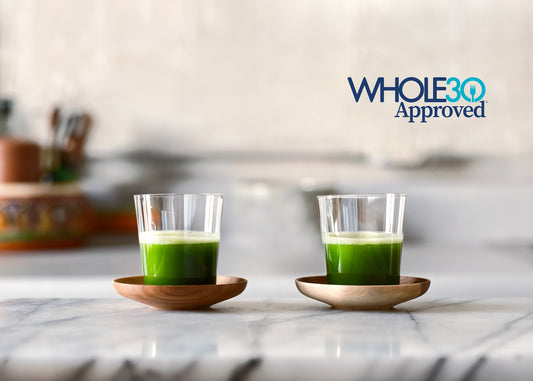
Cuzen Matcha is Whole30 approved
Thanks to our commitment to 100% organic, whole leaves, Cuzen Matcha is now a Whole30 approved partner.
Cuzen Matcha is Whole30 approved
Thanks to our commitment to 100% organic, whole leaves, Cuzen Matcha is now a Whole30 approved partner.
-

Talking with Japanese calligrapher, Aoi Yamaguchi
Both innovator and master, the collaborating artist on our Sumi Black launch brings depth to design.
Talking with Japanese calligrapher, Aoi Yamaguchi
Both innovator and master, the collaborating artist on our Sumi Black launch brings depth to design.
-
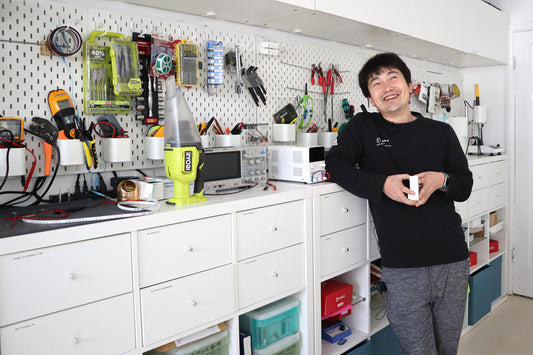
Meet Naoto, our mechanical engineer
With tea farming roots and an unflappable commitment to UX, Naoto was the best man for the job.
Meet Naoto, our mechanical engineer
With tea farming roots and an unflappable commitment to UX, Naoto was the best man for the job.
-
Organic Matcha Leaf packets
Regular price From $17.00USDRegular priceUnit price / per$17.00USDsale From $17.00USD -
Matcha Maker Starter Kit
Regular price $299.00USDRegular priceUnit price / per -
Organic Single Origin
Regular price From $45.00USDRegular priceUnit price / per -
Matcha Maker Gift Starter Kit
Regular price From $349.00USDRegular priceUnit price / per
